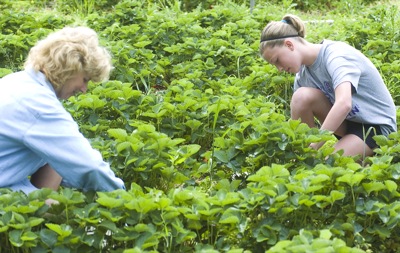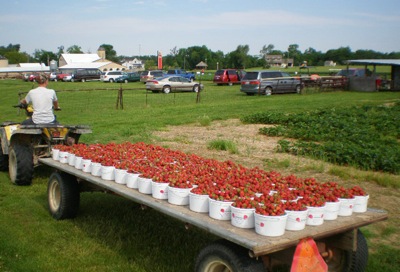Thursday, June 3rd, 2010
Berries jam fruit farms
By Shelley Grieshop

Photo by Mark Pummell/The Daily Standard
Kris Vogel, left, and Kirsten Jutte pick strawberries Wednesday morning at Jutte's Fruit Farm & Landscaping in Fort Recovery. This year's crop was blessed with good weather conditions that brought high yields, according to owner Oscar Jutte.
Perfect weather conditions led to an early strawberry harvest and an abundance of the juicy, red fruit at local farms.
Oscar Jutte of Jutte's Fruit Farm & Landscaping in Fort Recovery said this year's bumper crop began to ripen in mid-May - the earliest in more than 20 years.
"Some people don't even realize we've been pickin' for about two weeks already," Jutte said.
Normally he hires Amish teens to begin picking the sweet summer berries the first week of June, he said. But mild weather in April accelerated the bloom process, which was slowed only briefly by a cold spell in May, he said.
"Everything's early this year, trees, flowers," Jutte added.
Jutte said the success of his crop is partly determined in September and October when the previous year's buds set.
"Then the next trick is to get them through the winter. If I don't see my strawberries from Christmas to March, I'm happy," he said.
One great year out of five is typical and this year is that windfall, he added.
Maurus Brown, associate professor and extension specialist at The Ohio State University (OSU) South Centers in Piketon, said it's a very good strawberry year across the state. The university's research plots also did well, he said.
"Everyone seems to have good fruit quality and good yields," Brown said.
Besides the weather, Brown credits a system called "plasticulture" for the success of the strawberry plants in the research garden. The plasticulture process involves mounding the soil and covering it with plastic sheeting. Strawberry plant plugs are inserted in the mounds each September for the late May harvest.
The plasticulture method reportedly increases yields and promotes a lengthier harvest time, experts say.
The traditional "matted row" method - used by Jutte - grows the plant in mulched soil and, unlike the plasticulture method, allows vining shoots to grow and form the plants into a matted row.
Fulton Farms in Troy - a major supplier for this weekend's Troy Strawberry Festival - uses plasticulture for most of their strawberry plants and other crops such as sweet corn, Jim Fulton said. His father, Bill, was a pioneer in plasticulture and began experimenting with the process in the early '60s.
"It makes a high-quality berry and it's actually better for the plants," Fulton said.
The plasticulture process promotes less disease by keeping plants up and out of floodwaters. The plastic reduces weeds and keeps the warmth inside to promote growth, Fulton said. The drawback is the cost: growers typically replant each season to maintain high yields; matted row growers usually replant every three to four years.
Jutte said he'll continue to use the matted row process - the same practice his mother used when she started the business in the early '50s, he said.
"There's so much more work involved with the plasticulture (method)," he said. "We investigated it three to four years ago, but it didn't prove to be the way to go here. It's just a whole new ballgame."
Bunch of berries:
• $5 million - what Ohio's strawberry crop brings in each year to fruit farmers.
• 801 - the number of strawberry acres harvested each year in Ohio.
• 375 - the number of strawberry growers in the state.
• 200 - the approximate number of seeds on the outside of each berry.
• 3.4 pounds - the average amount of fresh strawberries each American eats annually.
- Shelley Grieshop

Submitted Photo
Buckets and buckets of berries are moved out of the fields at Jutte's fruit farm near Fort Recovery. Berries can be purchased at the farm along state Route 49 or customers can pick their own from the fields.



